Do you have a question about the Panasonic TH-42LRU5 and is the answer not in the manual?
Ensures reliable operation and protects the TV from overheating by maintaining adequate space.
Formal statement confirming the TV meets FCC standards for digital devices.
Provides recommendations for safe installation and general use of the flat panel display.
Outlines essential precautions and requirements for safely mounting the TV on a wall.
Identifies standard accessories like the remote control, batteries, and operating instructions.
Details the optional wall-hanging bracket and its installation considerations.
Instructions for physically assembling the TV's base stand components.
Steps for securely attaching the assembled pedestal to the TV unit.
How to rotate the TV stand for optimal viewing angles.
Instructions for securing the TV to a desk or table using wood screws.
Details the AV IN and HDMI ports located on the side of the TV.
Lists various input/output terminals found on the back of the TV.
Instructions for connecting VHF/UHF antennas for broadcast reception.
How to connect devices via HDMI for high-definition digital images and sound.
Details connecting devices using component video and audio cables.
Connecting devices via composite video and audio cables.
Details connection for MTI (Multiple Television Interface) equipment.
Guide on connecting a personal computer to the TV.
Locates and explains the physical controls and indicators on the TV unit.
Explains the functions of buttons on the remote control for TV operation.
Steps to power on the TV and select channels using the remote or TV controls.
Covers functions like SAP audio, closed caption, and aspect ratio adjustment.
How to access the menu to select external input sources.
Guidance on using the remote control for connected video and DVD players.
Steps to select the PC input source from the input select menu.
How to adjust PC picture settings like sync, dot clock, and position.
Instructions for correctly inserting an SD card into the TV's slot.
How to browse and select image files stored on the SD card.
Options for viewing images, such as single view or slideshow.
Options to configure frame, photo effects, transition effects, and music for slideshows.
How to select background music for the slideshow playback.
Details how to adjust picture and audio parameters for the image viewer.
Steps to access and configure the Hotel Mode settings.
Explains various settings within the Hotel Mode menu like Mode, TA Ctrl, and Lock.
Guide on how to open and navigate through the TV's menu system.
How to select specific items and adjust their settings within the menus.
Comprehensive list of picture adjustments including mode, backlight, and color.
Covers adjustments for Bass, Treble, and Balance for audio output.
Details surround sound, volume leveler, and speaker settings.
Options for sleep timer, program lock, closed caption, and input labels.
Settings for power saving modes like Power save and No signal auto-off.
Lists operations enabled by different versions of HDAVI Control.
Specifies the type of HDMI cable needed for VIERA Link functionality.
How to connect a Panasonic DIGA DVD recorder for VIERA Link.
Guide for connecting home theater systems or AV amplifiers.
Instructions for connecting camcorders or digital cameras via HDMI.
Steps to enable VIERA Link functionality through the setup menu.
How to configure power off link and default speaker settings.
Automatically switches TV input based on playback from connected devices.
Turns off connected VIERA Link compatible equipment when the TV is powered off.
Minimizes lip-sync delays between picture and audio.
Information about TV settings that can be transmitted to compatible equipment.
Steps to access the channel locking features through the menu.
How to enter a 4-digit password for locking programs or changing settings.
Choosing between 'On' or 'Off' modes for program locking.
Using V-chip technology to lock shows based on TV ratings.
Choosing specific rating categories (e.g., MPAA, U.S. TV) to apply locks.
Selecting a specific rating within a category to lock.
Procedure for changing the existing password for lock settings.
Steps to open the main menu to access setup options.
Navigating to the ANT/Cable setup section for channel tuning.
Choosing between auto program or manual program for channel setup.
Performing an automatic scan and save of available channels.
Adding or skipping channels, and editing channel captions.
Using the signal meter to check channel signal strength.
Steps to turn on closed captions for displaying subtitles.
Configuring text size, font, color, and other display options for captions.
Restoring closed caption settings to their factory defaults.
Labeling external input terminals for easier identification.
Turning audio output on or off for specific input terminals.
How to open and navigate the simplified Guest menu.
Details settings like language, screen format, and sleep timer in the Guest menu.
Accessing the Hotel Mode menu to prepare for Signage Mode.
Setting the initial input source to SD card for digital signage.
Saving the configuration and starting the slideshow for digital signage.
Instructions for preparing a JPEG image file on an SD card.
Accessing the Hotel Mode menu to load the welcome image.
Choosing the welcome image file and initiating the loading process.
Explains common error messages encountered during image loading.
Important notes regarding welcome image display timing and operations.
How to change the duration the welcome image is displayed.
Steps to initiate the local authentication process using an SD card.
Entering the Hotel ID and copying authentication data.
Procedures to restart the TV and confirm local authentication mode activation.
Steps to set up the channel remapping function using an SD card.
Entering the password and following on-screen prompts for channel remapping.
How to restart the TV after the channel remapping process is complete.
Creating a startup file on an empty SD card using a PC.
Copying the master TV settings to the prepared SD card.
Transferring cloned settings from the SD card to multiple TVs.
Explains movie rating categories and their meanings for locking.
Details TV program rating categories and content descriptions.
Information on Canadian English and French rating systems.
Explains CC display requirements for digital broadcasting and signal types.
Details the different aspect ratio modes (FULL, JUST, H-FILL, ZOOM) for image display.
Adjusts the horizontal display range to reduce image noise.
Specifies supported file formats and image resolution for SD card browsing.
Important precautions for safely handling and using SD cards with the TV.
Explains common warning messages related to SD card usage.
Information on connecting devices via HDMI, including compatible signals and cable types.
Explains the different picture modes (Vivid, Standard, Cinema, Custom) available.
Details the connection and pin layout for the MTI terminal.
Lists supported horizontal and vertical frequencies for Component, HDMI, and PC inputs.
Information on PC input terminals, resolution, and signal names.
Explains how VIERA Link allows automatic interfacing with Panasonic equipment.
Addresses issues like white spots, frozen images, and distorted pictures.
Solutions for no sound, unusual sounds, and non-working remote controls.
Troubleshooting recording failures and HDMI connection distortions.
Covers issues like bright/dark spots, chaotic images, and blank screens.
Addresses no sound, unusual sounds, and sound mute issues.
Explains sounds from the cabinet, tick/click sounds, and unit heat.
Proper methods for cleaning the TV's delicate display panel.
Instructions for cleaning the TV's cabinet and pedestal stand.
How to clean the power cord plug for safety.
Details power consumption, panel size, and speaker specifications.
Lists available connection terminals and key features like V-Chip.
Provides the dimensions and weight of the TV with and without the stand.
Ensures reliable operation and protects the TV from overheating by maintaining adequate space.
Formal statement confirming the TV meets FCC standards for digital devices.
Provides recommendations for safe installation and general use of the flat panel display.
Outlines essential precautions and requirements for safely mounting the TV on a wall.
Identifies standard accessories like the remote control, batteries, and operating instructions.
Details the optional wall-hanging bracket and its installation considerations.
Instructions for physically assembling the TV's base stand components.
Steps for securely attaching the assembled pedestal to the TV unit.
How to rotate the TV stand for optimal viewing angles.
Instructions for securing the TV to a desk or table using wood screws.
Details the AV IN and HDMI ports located on the side of the TV.
Lists various input/output terminals found on the back of the TV.
Instructions for connecting VHF/UHF antennas for broadcast reception.
How to connect devices via HDMI for high-definition digital images and sound.
Details connecting devices using component video and audio cables.
Connecting devices via composite video and audio cables.
Details connection for MTI (Multiple Television Interface) equipment.
Guide on connecting a personal computer to the TV.
Locates and explains the physical controls and indicators on the TV unit.
Explains the functions of buttons on the remote control for TV operation.
Steps to power on the TV and select channels using the remote or TV controls.
Covers functions like SAP audio, closed caption, and aspect ratio adjustment.
How to access the menu to select external input sources.
Guidance on using the remote control for connected video and DVD players.
Steps to select the PC input source from the input select menu.
How to adjust PC picture settings like sync, dot clock, and position.
Instructions for correctly inserting an SD card into the TV's slot.
How to browse and select image files stored on the SD card.
Options for viewing images, such as single view or slideshow.
Options to configure frame, photo effects, transition effects, and music for slideshows.
How to select background music for the slideshow playback.
Details how to adjust picture and audio parameters for the image viewer.
Steps to access and configure the Hotel Mode settings.
Explains various settings within the Hotel Mode menu like Mode, TA Ctrl, and Lock.
Guide on how to open and navigate through the TV's menu system.
How to select specific items and adjust their settings within the menus.
Comprehensive list of picture adjustments including mode, backlight, and color.
Covers adjustments for Bass, Treble, and Balance for audio output.
Details surround sound, volume leveler, and speaker settings.
Options for sleep timer, program lock, closed caption, and input labels.
Settings for power saving modes like Power save and No signal auto-off.
Lists operations enabled by different versions of HDAVI Control.
Specifies the type of HDMI cable needed for VIERA Link functionality.
How to connect a Panasonic DIGA DVD recorder for VIERA Link.
Guide for connecting home theater systems or AV amplifiers.
Instructions for connecting camcorders or digital cameras via HDMI.
Steps to enable VIERA Link functionality through the setup menu.
How to configure power off link and default speaker settings.
Automatically switches TV input based on playback from connected devices.
Turns off connected VIERA Link compatible equipment when the TV is powered off.
Minimizes lip-sync delays between picture and audio.
Information about TV settings that can be transmitted to compatible equipment.
Steps to access the channel locking features through the menu.
How to enter a 4-digit password for locking programs or changing settings.
Choosing between 'On' or 'Off' modes for program locking.
Using V-chip technology to lock shows based on TV ratings.
Choosing specific rating categories (e.g., MPAA, U.S. TV) to apply locks.
Selecting a specific rating within a category to lock.
Procedure for changing the existing password for lock settings.
Steps to open the main menu to access setup options.
Navigating to the ANT/Cable setup section for channel tuning.
Choosing between auto program or manual program for channel setup.
Performing an automatic scan and save of available channels.
Adding or skipping channels, and editing channel captions.
Using the signal meter to check channel signal strength.
Steps to turn on closed captions for displaying subtitles.
Configuring text size, font, color, and other display options for captions.
Restoring closed caption settings to their factory defaults.
Labeling external input terminals for easier identification.
Turning audio output on or off for specific input terminals.
How to open and navigate the simplified Guest menu.
Details settings like language, screen format, and sleep timer in the Guest menu.
Accessing the Hotel Mode menu to prepare for Signage Mode.
Setting the initial input source to SD card for digital signage.
Saving the configuration and starting the slideshow for digital signage.
Instructions for preparing a JPEG image file on an SD card.
Accessing the Hotel Mode menu to load the welcome image.
Choosing the welcome image file and initiating the loading process.
Explains common error messages encountered during image loading.
Important notes regarding welcome image display timing and operations.
How to change the duration the welcome image is displayed.
Steps to initiate the local authentication process using an SD card.
Entering the Hotel ID and copying authentication data.
Procedures to restart the TV and confirm local authentication mode activation.
Steps to set up the channel remapping function using an SD card.
Entering the password and following on-screen prompts for channel remapping.
How to restart the TV after the channel remapping process is complete.
Creating a startup file on an empty SD card using a PC.
Copying the master TV settings to the prepared SD card.
Transferring cloned settings from the SD card to multiple TVs.
Explains movie rating categories and their meanings for locking.
Details TV program rating categories and content descriptions.
Information on Canadian English and French rating systems.
Explains CC display requirements for digital broadcasting and signal types.
Details the different aspect ratio modes (FULL, JUST, H-FILL, ZOOM) for image display.
Adjusts the horizontal display range to reduce image noise.
Specifies supported file formats and image resolution for SD card browsing.
Important precautions for safely handling and using SD cards with the TV.
Explains common warning messages related to SD card usage.
Information on connecting devices via HDMI, including compatible signals and cable types.
Explains the different picture modes (Vivid, Standard, Cinema, Custom) available.
Details the connection and pin layout for the MTI terminal.
Lists supported horizontal and vertical frequencies for Component, HDMI, and PC inputs.
Information on PC input terminals, resolution, and signal names.
Explains how VIERA Link allows automatic interfacing with Panasonic equipment.
Addresses issues like white spots, frozen images, and distorted pictures.
Solutions for no sound, unusual sounds, and non-working remote controls.
Troubleshooting recording failures and HDMI connection distortions.
Covers issues like bright/dark spots, chaotic images, and blank screens.
Addresses no sound, unusual sounds, and sound mute issues.
Explains sounds from the cabinet, tick/click sounds, and unit heat.
Proper methods for cleaning the TV's delicate display panel.
Instructions for cleaning the TV's cabinet and pedestal stand.
How to clean the power cord plug for safety.
Details power consumption, panel size, and speaker specifications.
Lists available connection terminals and key features like V-Chip.
Provides the dimensions and weight of the TV with and without the stand.
| Screen Size | 42 inches |
|---|---|
| Display Technology | LCD |
| Aspect Ratio | 16:9 |
| Brightness | 500 cd/m² |
| Response Time | 8 ms |
| HDMI Ports | 2 |
| USB Ports | 1 |
| Resolution | 1920 x 1080 |
| Viewing Angle | 178° |
| Inputs | HDMI, USB, Component, Composite |


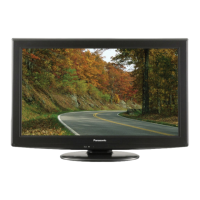




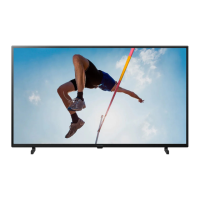
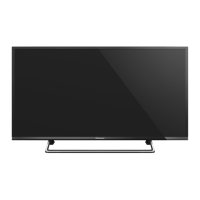
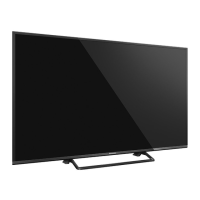
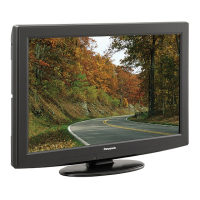

